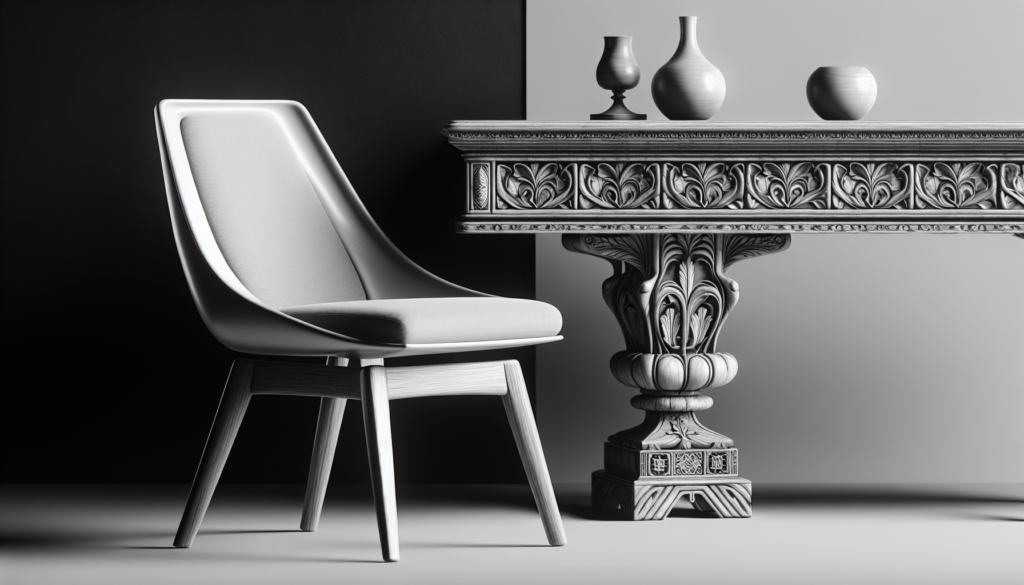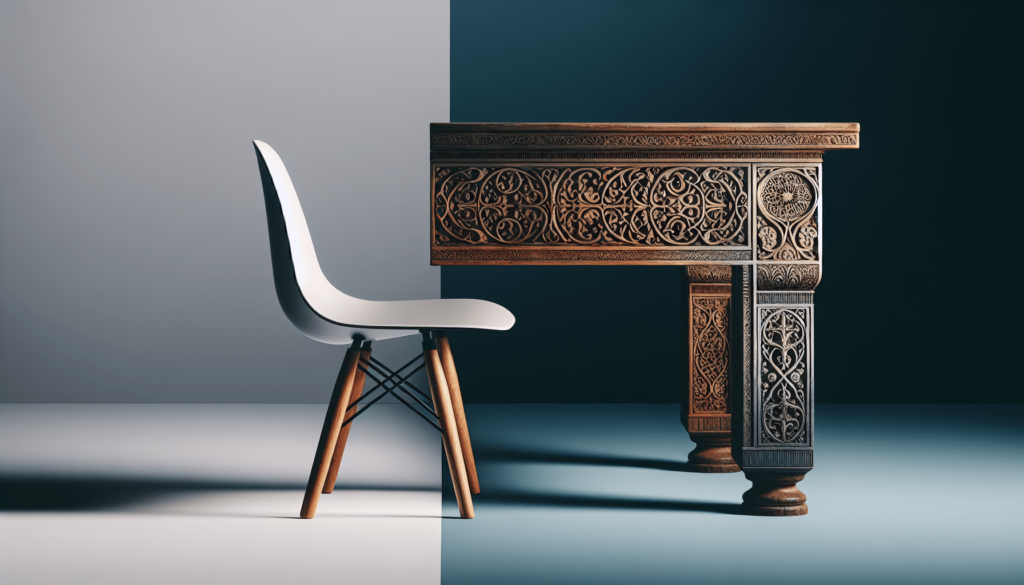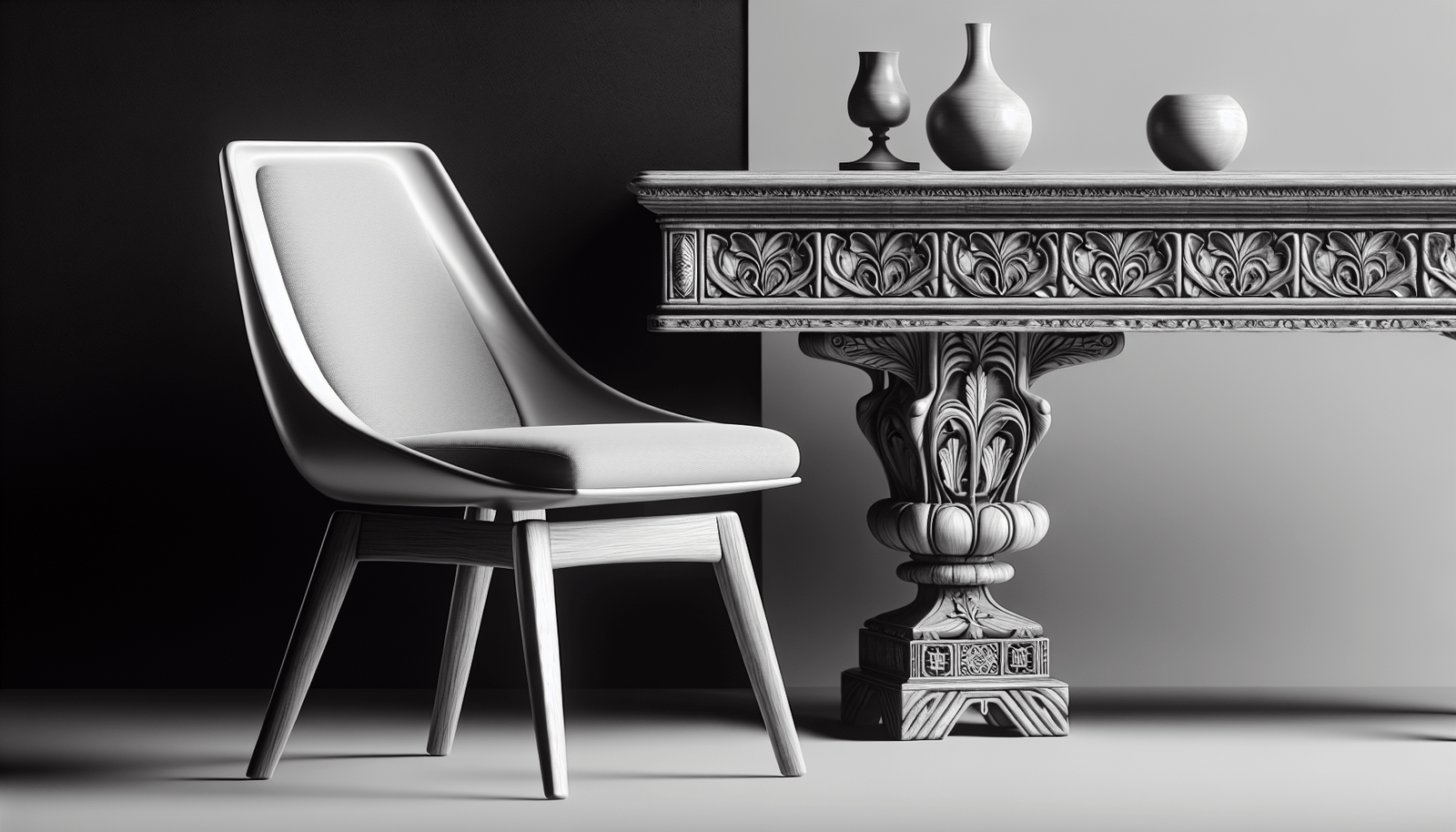Are you looking to create a unique and stylish home decor that seamlessly blends modern and antique furniture? Look no further! This beginner’s guide has got you covered. With expert tips and advice, you’ll learn how to create a harmonious and balanced interior design that combines the best of both worlds. Whether you’re a fan of contemporary minimalism or vintage charm, this guide will help you navigate the world of mixing modern and antique furniture with ease. So get ready to transform your home into a captivating space that reflects your personal style and takes your guests’ breath away.

Understanding the Style
Defining modern furniture
Modern furniture refers to furniture pieces that are created in the present time or influenced by contemporary design aesthetics. It encompasses clean lines, simplicity, and functionality. The focus is on minimalism and the use of materials like glass, steel, and plastic. Modern furniture often features geometric shapes and bold colors, and it is known for its sleek and streamlined look.
Defining antique furniture
Antique furniture, on the other hand, refers to furniture items that are at least 100 years old. It represents the craftsmanship and design aesthetics of a particular time period. Antique furniture can range from ornately carved pieces from the Victorian era to simpler designs from the Arts and Crafts movement. It is characterized by its unique details, intricate craftsmanship, and the use of premium materials like solid wood, brass, and velvet.
Identifying the Key Elements
Identifying modern furniture characteristics
To identify modern furniture, look for the following characteristics:
-
Clean lines: Modern furniture typically features straight, clean lines that create a minimalist look.
-
Simple shapes: Geometric shapes like squares, rectangles, and circles are commonly seen in modern furniture.
-
Minimal ornamentation: Modern furniture tends to have minimal ornamentation, focusing instead on the beauty of the materials and form.
-
Use of industrial materials: Materials like glass, steel, and plastic are commonly used in modern furniture designs.
-
Bold colors: Modern furniture often incorporates bold and vibrant colors, adding a pop of visual interest to the space.
Identifying antique furniture characteristics
To identify antique furniture, keep an eye out for the following characteristics:
-
Ornate details: Antique furniture is known for its intricately carved details and embellishments that showcase the craftsmanship of the era it belongs to.
-
High-quality materials: Antique furniture is typically made from premium materials like solid wood, brass, and velvet, which add to its durability and beauty.
-
Unique design elements: Antique furniture often features unique design elements that reflect the particular time period it belongs to, such as curved legs or decorative motifs.
-
Patina and wear: Antique furniture may show signs of wear, such as faded finishes or natural patina, which adds to its charm and authenticity.
-
Classic color palettes: Antique furniture is commonly seen in classic color palettes, such as rich woods, deep mahoganies, and muted earth tones.
Choosing a Focal Point
Selecting a dominant piece
When mixing modern and antique furniture, it’s essential to choose a dominant piece that will act as the focal point in the room. This could be a standout modern sofa, a unique antique dining table, or even a statement artwork. The dominant piece will set the tone and style for the rest of the furniture in the space.
Consider the size, shape, and style of the dominant piece to ensure it complements the overall aesthetic you want to achieve. For example, if you have a large modern sectional sofa, you may choose to pair it with smaller antique side tables or accent chairs to create a visually balanced composition.
Mixing styles around the focal point
Once you have selected the dominant piece, it’s time to mix styles around it. To create a harmonious blend, choose furniture pieces that complement the dominant piece in terms of color, shape, and scale. For instance, if you have a mid-century modern coffee table as the focal point, you could pair it with antique armchairs upholstered in a complementary color or patterned fabric.
Remember, the key is to balance the styles rather than overwhelming the space with too many contrasting elements. Mixing modern and antique furniture should create a cohesive and visually appealing look that showcases the best of both styles.
Consider the Proportions
Balancing the size and scale of furniture
When mixing modern and antique furniture, it’s crucial to consider the proportions of each piece. A well-balanced composition can be achieved by pairing furniture items of similar scale and size.
For example, if you have a large antique dining table, consider pairing it with substantial modern dining chairs that can hold their own in the space. On the other hand, if you have a petite antique writing desk, complement it with a modern task chair that is not overly large or overpowering.
By paying attention to the size and scale of the furniture pieces, you can create a visually balanced arrangement that allows each item to shine.
Creating visual harmony
In addition to size and scale, creating visual harmony through furniture placement is essential when mixing modern and antique pieces. Position furniture items in a way that creates a sense of balance and flow in the room.
Consider the overall layout and ensure that there is enough space between each item to avoid a cluttered look. Pay attention to the lines and angles of the furniture and arrange them in a way that creates a cohesive visual flow.
For example, if you have a modern couch and an antique sideboard, placing them on opposite sides of the room can create a sense of symmetry and visual harmony. Additionally, consider the sightlines in the room and ensure that each furniture item is placed in a way that allows for easy navigation and interaction within the space.

Playing with Colors
Embracing contrasting color palettes
Mixing modern and antique furniture offers an excellent opportunity to play with contrasting color palettes. Using contrasting colors can add visual interest and make each piece stand out.
Consider using a bold modern piece in a vibrant color, such as a red armchair, against a backdrop of neutral antique furniture. This creates a striking contrast and draws attention to the unique characteristics of each item.
Alternatively, you can opt for a more subtle contrast by pairing antique furniture with modern pieces in complementary colors. For example, a vintage wooden dresser can be complemented by a modern lamp in a color that echoes one of the hues found in the dresser’s wood grain.
Using neutrals to unify the space
While contrasting colors can create a dynamic look, using neutrals to unify the space can also be an effective strategy when mixing modern and antique furniture.
Choose a neutral color palette, such as whites, grays, and beiges, as the foundation for the room. This allows the different furniture styles to coexist harmoniously while creating a calm and timeless atmosphere.
You can use neutral-colored walls, floors, and large furniture pieces as a backdrop, and then incorporate pops of color through accessories, textiles, and smaller decorative items. This way, both the modern and antique pieces can shine without competing for attention.
Mixing Materials and Textures
Combining different textures
Mixing materials and textures is another way to create visual interest when combining modern and antique furniture.
Consider pairing a sleek, glossy modern coffee table with a rough-textured antique rug. The contrast between the smooth surface of the table and the textured, worn rug can create a visually captivating juxtaposition.
You can also mix different materials, such as glass, wood, metal, and fabric, to add depth and variety to the space. For example, a modern glass dining table can be paired with antique wooden chairs, creating a beautiful blend of contemporary and traditional materials.
Integrating various materials
Integrating various materials can help create a cohesive look when mixing modern and antique furniture. Look for materials that bridge the gap between the different styles and tie them together.
For instance, if you have a modern leather sofa, consider adding antique wooden side tables. The warm tones and natural textures of the wood can complement the sleekness of the leather, creating a harmonious blend of materials.
Using materials that have similar finishes or undertones can also help create consistency within the space. For example, if you have a modern stainless steel kitchen, you can incorporate antique copper cookware or accessories to add warmth and texture to the overall design.
Blending Time Periods
Choosing complementary time periods
When mixing modern and antique furniture, it’s essential to choose time periods that complement each other aesthetically.
For example, if you have a mid-century modern sofa, you may want to pair it with vintage pieces from the same era, such as a retro coffee table or a vintage armchair. This creates a cohesive look that celebrates the design aesthetics of a specific time period.
Alternatively, you can mix styles from different eras that share common design elements. For instance, combining an antique chandelier with a modern dining table with curved legs can create an eclectic blend that showcases the best of both styles.
Incorporating transitional pieces
Transitional pieces can bridge the gap between modern and antique styles, creating a seamless transition between the two.
Look for furniture pieces that have elements of both modern and antique design. For example, a modern sofa with classic tufted upholstery can serve as a transitional piece that can complement both contemporary and traditional furniture.
Transitional pieces can help create a cohesive and balanced look, especially when integrating furniture pieces from different time periods.
Creating a Cohesive Layout
Arranging furniture for balance
When arranging furniture, strive for balance and symmetry to create a cohesive layout when mixing modern and antique pieces.
Start by identifying a focal point or anchor in the room, such as a fireplace or a large window. Arrange the furniture around that focal point, ensuring that the different styles are evenly distributed throughout the space.
Consider the visual weight of each furniture piece and its relationship to the other items in the room. For example, if you have a large antique armoire on one side of the room, you may want to balance it out with a group of modern artwork on the opposite wall.
Additionally, leave enough space for easy movement and circulation in the room, ensuring that furniture pieces are not overcrowded or obstructing pathways.
Grouping similar styles together
While balance is important, grouping similar styles together can also create a cohesive and visually pleasing layout.
For example, you can create a dedicated seating area with a mix of modern and antique furniture. Place a modern sofa with modern side tables and complement it with antique armchairs and an antique coffee table. This grouping of similar styles creates a cohesive conversation area that showcases the best of both modern and antique design.
By creating intentional groupings, you can highlight the unique characteristics of each style while ensuring that they work together harmoniously.
Accessorizing with Decor
Incorporating decorative elements
Accessorizing is a crucial part of any interior design, and it plays a significant role when mixing modern and antique furniture.
Incorporate decorative elements that enhance the overall aesthetic and blend the different styles seamlessly. For example, you can add modern artwork to the walls, complemented by vintage picture frames or mirrors.
Consider incorporating decorative accessories like vases, sculptures, or lamps that bridge the gap between the modern and antique styles. Look for unique pieces that add personality and character to the space while complementing the furniture.
Adding personal touches
Mixing modern and antique furniture allows for personalization and the addition of unique touches that reflect your individual taste and style.
Choose items that have personal significance, such as family heirlooms or vintage finds that hold sentimental value. These personal touches can add depth and a sense of history to the space, making it feel truly curated and meaningful.
Consider incorporating personal photographs, artwork, or objects that tell a story and contribute to the overall narrative of the room.
Seeking Professional Help
Consulting an interior designer
If you’re unsure about how to mix modern and antique furniture effectively, consider consulting an interior designer.
Interior designers can provide expert advice on furniture selection, layout, and overall design aesthetics. They can work with you to understand your vision and help bring it to life while ensuring a harmonious blend of different styles.
An interior designer can also provide guidance on sourcing furniture, choosing colors, and incorporating accessories to create a cohesive and visually appealing space that reflects your personal style.
Finding antique and vintage experts
When it comes to antique and vintage furniture, it’s important to seek the guidance of experts who specialize in these areas.
Antique and vintage experts can help you determine the authenticity and value of antique furniture pieces, as well as provide advice on restoration and maintenance. They have the knowledge and experience to guide you in finding high-quality, genuine pieces that align with your design goals.
Seeking their professional help can ensure that you make informed decisions when purchasing antique furniture and that you create a collection that will withstand the test of time.
In conclusion, mixing modern and antique furniture is a wonderful way to create a unique and personalized space that showcases both old and new design aesthetics. By understanding the characteristics of each style, choosing a focal point, considering proportions, playing with colors, mixing materials and textures, blending time periods, creating a cohesive layout, accessorizing with decor, and seeking professional help when needed, you can achieve a harmonious and visually appealing blend of different furniture styles. So go ahead and unleash your creativity and start mixing modern and antique furniture to create a truly one-of-a-kind and timeless interior that reflects your personal style.

